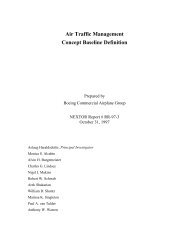Establishing an Upper-Bound for the Benefits of NextGen Trajectory ...
Establishing an Upper-Bound for the Benefits of NextGen Trajectory ...
Establishing an Upper-Bound for the Benefits of NextGen Trajectory ...
You also want an ePaper? Increase the reach of your titles
YUMPU automatically turns print PDFs into web optimized ePapers that Google loves.
The Future ATM Concept Evaluation Tool (FACET 3 ) [5]was used <strong>for</strong> this experiment that included 19,900 domesticflights between 287 airports (4,170 O/D pairs). The experimentconsisted <strong>of</strong> two scenarios: (i) flights followed Great CircleDist<strong>an</strong>ce (GCD) routes from TRACON to TRACON, <strong>an</strong>d (ii)flights followed traditional navigation aid-based airway routes.The flights in each scenario used <strong>the</strong> same cruise flight levels<strong>an</strong>d cruise speeds. The results are summarized below:(i) Great Circle Dist<strong>an</strong>ce routes generated a total <strong>of</strong>598,724.8 nm (average 30.1 nm per flight) savings inreduced dist<strong>an</strong>ce flown.(ii) Great Circle Dist<strong>an</strong>ce routes resulted in a redistribution<strong>of</strong> ATC workload reducing <strong>the</strong> time sectors were above<strong>the</strong>ir Monitor Alert Threshold (MAP) from 32% to 21%.(iii) Great Circle Dist<strong>an</strong>ce routes resulted in reduced ATCworkload reducing <strong>the</strong> number <strong>of</strong> flights with conflictingtrajectories by 47%.These results establish <strong>an</strong> upper bound on <strong>the</strong> benefits tobe derived by <strong>Trajectory</strong>-based Operations. The result is awin-win scenario <strong>for</strong> both <strong>the</strong> airlines <strong>an</strong>d air traffic control.The use <strong>of</strong> Great Circle Dist<strong>an</strong>ce routes geographically redistributed<strong>the</strong> flights reducing workload in <strong>the</strong> most congestedsectors <strong>an</strong>d well as signific<strong>an</strong>tly reducing conflicts in flighttrajectories. It should also be noted that <strong>the</strong> use <strong>of</strong> Great CircleDist<strong>an</strong>ce routes did not alleviate <strong>the</strong> flight delays resultingfrom over-scheduled departure <strong>an</strong>d arrivals.This paper is org<strong>an</strong>ized as follows: Section 2 describes<strong>the</strong> design <strong>of</strong> <strong>the</strong> experiment, <strong>the</strong> simulation used <strong>for</strong> <strong>the</strong>experiment, <strong>an</strong>d <strong>the</strong> configuration <strong>an</strong>d parameters used in <strong>the</strong>experiment, Section 3 describes <strong>the</strong> results <strong>of</strong> <strong>the</strong> experiment,<strong>an</strong>d Section 4 provides conclusions, implications <strong>of</strong> <strong>the</strong>seresults, <strong>an</strong>d future work.II. METHOD AND DESIGN OF THE EXPERIMENTThis section describes <strong>the</strong> design <strong>of</strong> <strong>the</strong> experiment <strong>an</strong>d <strong>the</strong>simulation environment used.The experiment was conducted using <strong>the</strong> Future ATMConcept Evaluation Tool (FACET) [5]. The tool has beenused in previous studies [3], [6], [7] to evaluate new TrafficFlow M<strong>an</strong>agement (TFM) concepts in <strong>the</strong> NAS. FACET <strong>of</strong>fersm<strong>an</strong>y options like <strong>the</strong> possibility connecting to real-time datasources <strong>for</strong> wea<strong>the</strong>r <strong>an</strong>d traffic, real-time conflict detection<strong>an</strong>d resolution, batch processing <strong>of</strong> input data (as <strong>an</strong> optionto real-time streams), <strong>an</strong>d a Java API 4 . In <strong>the</strong> absences <strong>of</strong>r<strong>an</strong>dom inputs (like wea<strong>the</strong>r phenomena) <strong>the</strong> simulation isdeterministic. The results will be <strong>the</strong> same regardless <strong>of</strong> <strong>the</strong>number <strong>of</strong> executions.O<strong>the</strong>r metrics <strong>of</strong> <strong>the</strong> system, like number <strong>of</strong> sectors orcenters flown, dist<strong>an</strong>ce flown, <strong>an</strong>d number <strong>of</strong> conflicts, c<strong>an</strong>be obtained from <strong>the</strong> API or from <strong>the</strong> GUI 5 .3 See www.aviationsystemsdivision.arc.nasa.gov/research/modeling/facet.shtml4 API: Application Program Interface.5 GUI: Graphical User Interface.A. The input files <strong>for</strong> FACETThe main input to FACET is <strong>the</strong> flight schedule, flight tracks<strong>an</strong>d cruise flight-levels. FACET accepts several <strong>for</strong>mats <strong>for</strong><strong>the</strong>se input files known as ASDI, TRX. To achieve <strong>the</strong> goals<strong>of</strong> this experiment, a TRX input file was generated based onactual historical data from <strong>the</strong> Airline On Time Per<strong>for</strong>m<strong>an</strong>ceData data provided by Bureau <strong>of</strong> Tr<strong>an</strong>sportation Statistics(BTS). The procedure <strong>for</strong> generating <strong>the</strong> TRX file is describedbellow:First, <strong>the</strong> sample TRX files that come with FACET wereparsed <strong>an</strong>d <strong>the</strong> O/D pairs <strong>an</strong>d corresponding flight pl<strong>an</strong>s wereextracted <strong>an</strong>d exported to a database.Second, <strong>the</strong> BTS Airline On-Time Per<strong>for</strong>m<strong>an</strong>ce (AOTP)data was queried to obtain a single day <strong>of</strong> domestic operations.The query extracted <strong>the</strong> O/D pair, <strong>the</strong> coordinates <strong>for</strong><strong>the</strong> airports (taken from a proprietary table), <strong>the</strong> scheduleddeparture <strong>an</strong>d arrival times, <strong>the</strong> flight <strong>an</strong>d tail numbers, <strong>an</strong>d<strong>the</strong> aircraft type (taken from a proprietary table related to OnTime by tail number). The results <strong>of</strong> this query are sorted,ascending, by scheduled departure time.For each record returned by <strong>the</strong> query <strong>the</strong> great circledist<strong>an</strong>ce <strong>of</strong> <strong>the</strong> O/D pair, <strong>the</strong> expected flight time (that is <strong>the</strong>difference <strong>of</strong> <strong>the</strong> scheduled departure <strong>an</strong>d arrival times bothconverted to GMT), <strong>the</strong> required ground speed (<strong>an</strong>d integernumber <strong>of</strong> knots), <strong>the</strong> heading (<strong>an</strong> integer number computedfrom <strong>the</strong> coordinates <strong>of</strong> <strong>the</strong> airports assuming 0 degrees <strong>for</strong>North heading, <strong>an</strong>d 90 degrees <strong>for</strong> West heading), <strong>an</strong>d <strong>the</strong>flight level (a uni<strong>for</strong>mly distributed r<strong>an</strong>dom integer numberfrom 200 to 450), <strong>an</strong>d <strong>the</strong> flight pl<strong>an</strong> (taken r<strong>an</strong>domly fromavailable pl<strong>an</strong>s <strong>for</strong> <strong>the</strong> O/D pair). The coordinates <strong>of</strong> <strong>the</strong>airports are converted into integer numbers with <strong>the</strong> <strong>for</strong>mat[+|-]DMS where D st<strong>an</strong>ds <strong>for</strong> degrees (two or three digits), Mst<strong>an</strong>ds <strong>for</strong> minutes (two digits), <strong>an</strong>d S st<strong>an</strong>ds <strong>for</strong> seconds (twodigits). FACET requires western longitudes to be negative.Third, <strong>for</strong> each group <strong>of</strong> records with <strong>the</strong> same GMT scheduleddeparture time one “TRACKTIME” record is written toa text file. The value <strong>of</strong> <strong>the</strong> TRACKTIME record is <strong>the</strong> GMTscheduled departure datetime converted into <strong>the</strong> number <strong>of</strong> seconds from J<strong>an</strong>uary 1,1970 GMT. After this TRACKTIME record, <strong>the</strong> individual“TRACK” records <strong>for</strong> <strong>the</strong> flights are written using <strong>the</strong> datacomputed in <strong>the</strong> second step. The process repeats until <strong>the</strong>reare no more records from <strong>the</strong> query. An input file generatedthis way does not track <strong>the</strong> flights through <strong>the</strong> NationalAirspace System. It only describes every flight with a singlerecord. So this file c<strong>an</strong> be used <strong>for</strong> simulation purposes only,not <strong>for</strong> playback in FACET.The file used in this experiment contains 19,900 domestic(USA) flights scheduled to departure from Friday July 27 2007at 05:30:00 GMT to Saturday July 28 2007 at 09:20:00 GMT.The actual l<strong>an</strong>ding datetime <strong>of</strong> <strong>the</strong> last flight differs between scenarios because flightscould be delayed or <strong>the</strong>y could fly different dist<strong>an</strong>ces.

















